Digital Art History
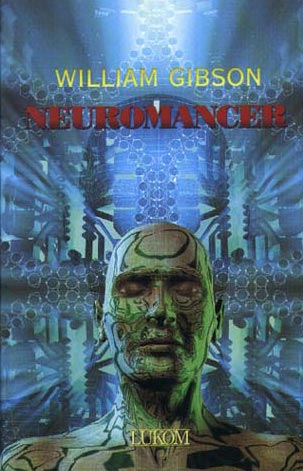
Neuromancer, by William Gibson (1984). The founation of cyberspace.
The 1980's.
The exponential takes off.
See the digital context.
Work in progress
The period is less ideological an more technological than the 60's. Oil crisis? Maturity of the tools?
From the end of the 1970's, the micro-computer, and notable the Apple II, give new wings to creators. They can use color and sound. They develop games as well as algorithmic art (with the fractals, widely appreciated). Complexity progresses on all its forms: resolution (image definition, sampling rates), enhanced interaction.
In some domains, artists become more pioneers than explorers: the new space is open and controlled, the problem is now to cultivate it. But the real explosion will happen in the next decade.
Software emerge, provided by the computer manufacturers, but also by specialized firms, and by some artists (Maeda, Leymarie). Some of the latter develop only for themselves, other ones aim to distribute their tools, on a friendly basis.
And don't forget that we quote here only the artists coming on the scene during this decade, but of course those of the precedent ones are still active, if not more than in their emerging time.
Events
- 1980. Pac-Man released by Namco
- 1983. Laurie Anderson's United States Part 1 and 2
- 1983-84. Electra, held from December 10, 1983 to February 5, 1984 at Musée d’Art Moderne de la Ville de Paris, Electra is designed by Marie-Odile Briot and Frank Popper (a major theorist of cinetic and new media art), a project funded by Electricité de France. "Electra was designed around two major axes. The first, historical. The second, showing brand new works, electronic or digigal, specially created for the show" (says [Popper 1] p.45, our translation). It afforded to show interactive and networked art works (pre-internet), including La Plissure du Texte by Roy Ascott.
- 1984. The term cyberspace is coined by William Gibson, in his Neuromancer.
- 1984. Plan Image in France, well active in the movement. Unortunately, for lack of sufficient coordination between business and politics, this strong momentum will fall down. TDI (Thomson Digital Image) is sold to an American corporation. And the US leaders break the French ambitions, sometimes with disputable means (see the Risset report). Siggraph France is created, as a French chapter of ACM SIggraph. It will become the present Paris ACM Siggraph.
- 1985. Les immatériaux, held from March 28 to July 15, at Centre Georges Pompidou. Designed by par Jean-François Lyotard, it aimed bo present the post-modern aesthetics and all its facets. Were shown the first "telematic" works and some automated text generators.
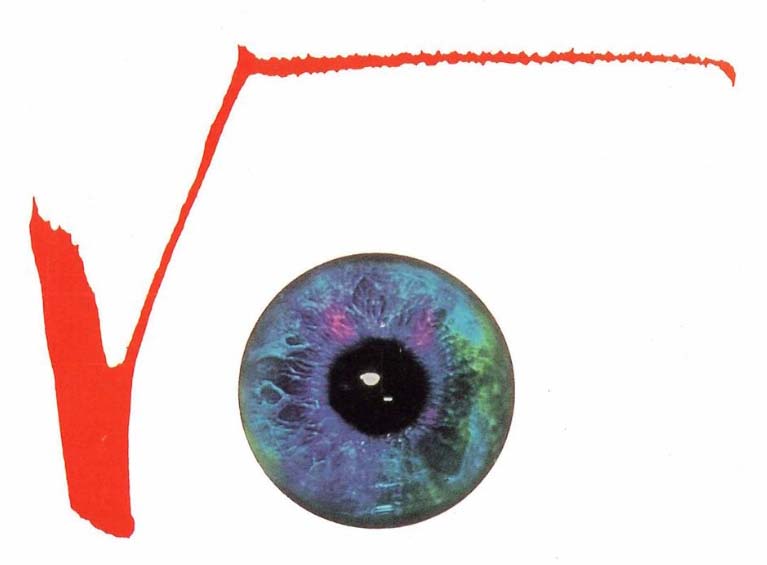
The Imagina Logo (sent by Gilbert Dutertre).
- 1985. Nicholas Negroponte founds the Media Lab within the MIT.
- 1985. Odorama at La Vilette's Cité des Sciences de La Villette
.
- 1985. Tsukuba scientific exposition, with an important part played by computer art. [Bonnefoy] p. 391.
- 1986. Rendez-vous Houston: A city in concert is performed by Jean-Michel Jarre ussing DCA projectofs, firewoks, and beamed images to illuminate a kilometer long wall of skyscrapers in downtown Houston.
- 1986-87. ZKM opens in Karlsruhe.
- 1986. The New Images Internatioinal Forum becoms Imagina (France).
- 1987. Artists Jennifer Bartlett, Richard Hamilton, David Hockney, Howard Hodgkins, Sidney Nolan and Larry Rivers are invited to use the Quantel Paintbox for BBC 2 TV series Painting with light. (Indicated by [Debatty]).
- 1988. Electronic arts festival (Festival des arts électroniques) in Rennes (Brittany): "Poetry plays peer to peer with science". See [Picon-Vallin] which gives the program.
- 1989. The Studio for Creative Inquiry, a center for experimental and interdisciplinary arts, is founded in the College of Fine ARts at Carnegie Mellon University.
- 1989. Alire, the most ancient review of digital poetry, is created in 1989. Edited by Philippe Bootz, Jean-Marie Dutey, Claude Maillard and Tibor Papp.
Jean-Pierre Balpe Text generation ad infinitum.
Literature
Literature and any kind of writing art is rapidly fond of text processing. First for the original typing, considerably more comfortable and efficient that the typewriter. A question remains unsolved: how far did these tools impact on the style of writers ? One thing is sure : they did not bring new literary genres. Even if the hypertext, then the mails, then the SMS, twitters... extended the toolbox.
As for properly digital creation, we can distinguish several different tracks.
- The combinatorial/generative creation of text. Here Jean-Pierre Balpe is the master, and will head the movement up to the 2010's. And Pierre Fourny
- The hyper-text: William Dickey (poetry) and Michael Joyce. Also Jay David Bolter, Amendent Hardiker.
- The prosody:
Claude Maillard's Théâtre de l’écriture (1986), a polyphonic text, for three voices plus a metronome.
- Use of video to present writing Ana Richardson.
- New fonts creation or enhancement. François Boltana, contrasting with Donald Knuth's algorithmic researches, uses the computer as a tool, on the screen, like a painter on Photoshop.
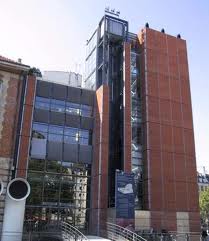
Ircam, a high place for sound and music.
The new technologies begins to impact the whole graphic chain, down to the printing presses themselves. That reduces the costs and increases quality. It is difficult in the 21st century to remember how poor press and publishing in genral were limited int heir presentations: few fonts, time consuming page setting, cost of correctinos. If for instance you open an issue of L'illustration, which was the luxury press all from 1880 (circa) to the 2d world war, the poverty is evident by comparison with even the cheapest of magazines, of which the number and circulation has strongly grown (and will perhaps vanish due to Internet, but they are still alive en 2013).
Music
Digital music instruments mutliply : synthesizers, electronic saxophones, trumpets or recorders. Some are created by artists like Ben Neill (also later a VJ).
The savant side of music is topped by
Pierre Boulez, abstract composer, director and leader of Ircam. We can quote also Jo Harvey, Vincent Lesbros,
Denis Lorrain, Patrick Moullet, Remko Scha and Horacio Vaggione.
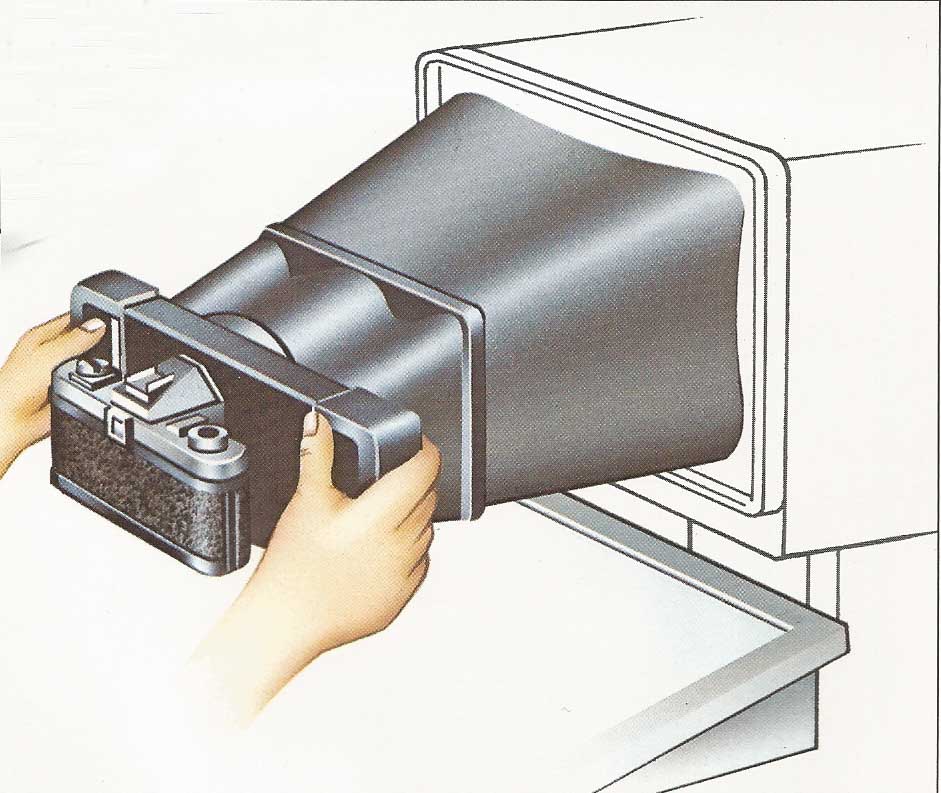
In the 1980's, color printers are rare and cosly. A comparatively cheap method takes picture from a screen. A small device may help to prevent inappropriate reflexions and set focussing once and for all. Picture from Les Images Electroniques, Time Magazine 1986.
As for popular music, in 1983. Two vinyles annouce house and techno : On&On, by DJ Jesse Saunders and Clear, by Cybotron. "These two maxi-discs will be the major influence on dance music to come, stir vocations and have a long lineage of heirs [Leloup, 2013], p. 14. A most fame composer and intepreter is Jean-Michel Jarre, combining music with grand light shows.
Götz Naleppa, a sound artist comes to digital.
Fred Voisin designs sound systems.
Painting and photography
Three events give an idea of the periods mood, where color palettes and image definition are still quite coarse (great news to come in the next decade).
[Masson] pp. 405 sq. gives a useful synthesis.
Typically Mark Wilson, during the nineteen seventies, Mark Wilson exhibited paintings and drawings in New York. His work was deeply involved with geometric imagery that had a distinctly technological flavor. In 1980, Wilson purchased a microcomputer and began to learn programming, with the goal of creating artworks.
- In 1984, Victor Acevedo paints his last oil canvas. Afterwards, he will use the computer exclusively.
- In
1986. Andy Warhol uses and Amiga to make portraits of himself and singer Deborah Harry. (Indicated by [Debatty]).
- In 1987. Artists Jennifer Bartlett, Richard Hamilton, David Hockney, Howard Hodgkins, Sidney Nolan and Larry Rivers are invited to use the Quantel Paintbox for BBC 2 TV series Painting with light. (Indicated by [Debatty])

Roman Verostko
As for music, we can separate a sort of "savant" computer painting, typically the algorists (not all of them adhere to the Jean-Piere Hébert group). Some of them add a little interaction to their works. Let's quote : Victor Acevedo, Mauro Annunziato, Peter Beyls, Paul Lohse, Tony Longson, Dario Perez-Florez, Brian Reffin Smith, Joan Truckenbrod, and Roman Verostko. Yoichiro Kawaguchi is more famed for his animations and animated sculputres. Also Jean-François Lacalmontie, using a software by Alain Longuet.
On the "pop" side, we have illustrators, or more generally artists using the computer mainly as a tool (what we tend to call "Photoshop painting", or "matte painting"): John Campbell, Gehrard Mantz (coming from traditional sculture, going to images and virtual reality), Roberto Matta and Barbara Nessim (illustrator). On the borders or philosophy or psychology, Knotter.
Painting or object making with traditional medias, but using computer for concepts and inspiration:
Victor Grillo and An Ursyn.
Jer Thorp visualizes "large data and the many-folded boundaries between science and art".
As for photography, scientific work is made by Louis Audoire (who cooperates with ATI in Paris 8 University) and Annie Cavanagh who enhances micrographic photos. More directly artisic are the composite photographs of Nancy Burson and
Thomas Porett.
Tibor Papp creates images from poetry.
Let's quot also Giros Albert Spain, and Braun Pierre France.
Algorithmic drawings on Macintosh by LWO.
Philippe Jeantet explores new techniques, generally oriented towards 2D pictures.
Animation, cinema, virtual reality
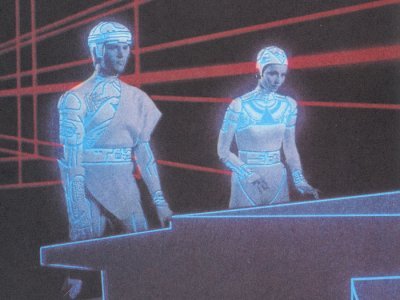
Stephen Lisberger: Tron (1982).
Digital cinema gets out of laboratories and enters even the mainstream market. The decade is marked by Tron (Stephen Lisberger), in 1982, the first full feature film using computer generated images. See echnical commentes in [Masson].
On the same year, about the robots as a dramatic subject, Ridley Scott films Blade Runnerbased on Philip K. Dick novel "Do androids dream of electronic sheep?".
But some pioneering works kees going on. John Lasseter:Luxo Jr (1986). Produced by Pixar. The famous short film with the table lamp. And it is a rich period of creativity: Philippe Bergeron, Pierre Lachapelle and Pierre Robidou:Tony de Peltrie.
Philippe Billion. A pioneer in image synthesis at Ex-Machina with Andy Gracie.
Daniel Borenstein and Paul Coudsi. Le stylo.
Marc Caro. Somewehre between computer and video
Adam Chin and Richard Cohen. Industrial opera, with Chin.
Larry Cuba. had made his first film in 1974, but played an important role in Starwars. In 1983, Return of the Jedy contained the holographic Endor moon sequence created by Lucas Film. Masson [Masson] indicates that Bill Reeves and Tom Duff used vector graphics to simulate raster graphics.
Stéphane Druais. Le pinceau électronique. Founder of today's Mikros Cy with Jean-Luc Savarin. 3D director.
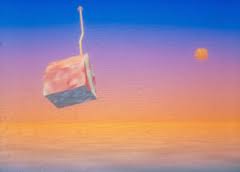
Maison Vole.
Takashi Fukumoto and Nishimura Hitoshi. Bio-sensor film.
Lauent Gartel, (compositing)
Alain Grach, André Martinand Philippe Quéau. Maison vole.
John Halas. Dilemma .
Kelichi Hara. Doraemon: Nobita's Great Adventure into the Underworld
Gary Hill. Video
Georges Lacroix. Fly Bill (1983c), a Sogitec production. His first 3D synthetic image film.
Michel Leuk. Quoted by Paris ACM Siggraph.
Larry Malone. Stanley and Stelly breaking the ice
Gehrt Mul. Video, installations, data base.
Monique Nahas. Gastronomica
RenatoFantome Cy.
Tamas Walicszky. Animation, painting.
Keith Waters. Expressions.
More scientific:
Denjean , on virtual reality.
Monika Fleischmannn r Fleischmann & Strauss developq Mixed Reality scenarios and work on a theory of Mixed Reality. They create artistic works, research prototypes, tools, interfaces and events intersecting interactive art, science and technology. "
Hervé Huitric generates images from bicubical B-splines.
Roland Kessler devekios the " integral image".
Cinema
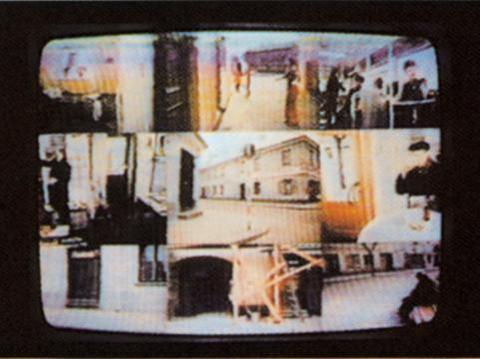
Zbignew Rybcsysnski. Advanced work on video montage and compositing.
Star Trek II: Wrath of Khan. (1982) by Loran Carpenter, Bill Reeves, Tom Porter, Rob Cook, Tom Duff and David DiFrancesco, directed by Alvy Ray Smith. The firls all-digital computer-generated image sequence, according to [Masson].
Let's quote also:
Robert Abel. "One of the genuine visionaries of digital computer graphics and visual effects.". Mainly cinema and video.
Michael Graumnitz. Digital video.
Zbignew Rybczinski. L'orchestre. "He plays on image processing, inlays, cutting and digital control of the camera"
Pascal Terracol. Artist and journalist.
Nil Yalter. Ethno-critical action through video and installations.
Design, objects, Architecture
Sculpture
See notice about Sculpture
Daniel Buren. On the borderline of digital, with its iterative structures.
Helaman Ferguson. Algorithmic.
Alain Le_Boucher. Combination of sculpture (wires) and LED art.
Richard Monnier. Sculpture with some image processing.
John Pickering. Complex.
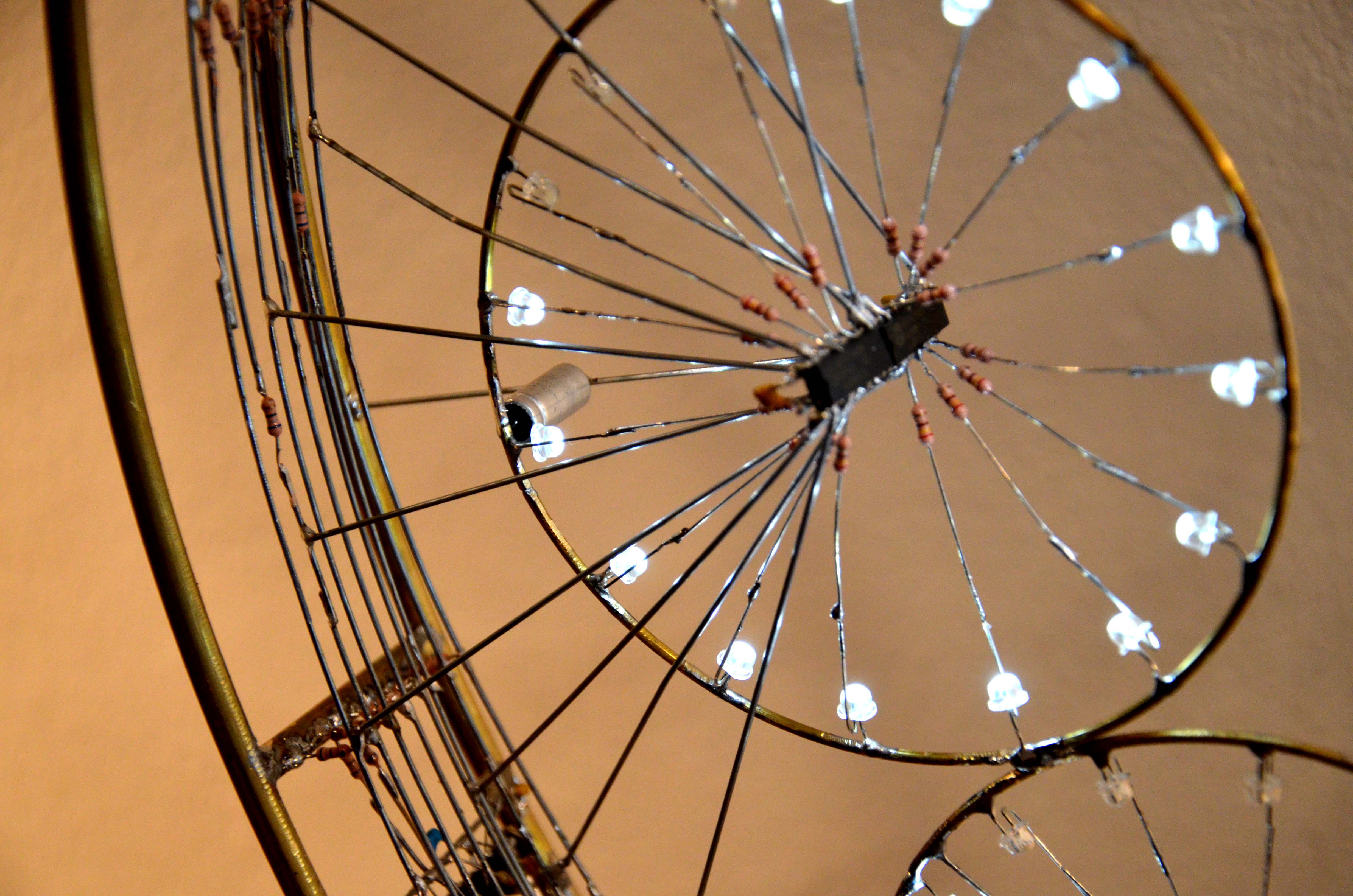
Alain Le Boucher: LEDs and micro-controllers on wire sculpture,
Light
Still more pre-digital than properly computerized, several artists make a more and more sophisticated use of lights:
- Holograms: Georges Dyens (and lasers), Paul_Frithiof Johansen.
- Laser (and music) Paul Earls.
- New projection techniques: Adalberto Mecarelli, Verjux Michel.
- Neon tubes François Morellet.
- Large scale shows and installations:
Yann Kersalé. Les murs ont des images.James Turrell. Installations and studies on perception.
- Ingo Maurer goes more and more digital with the years.
Cooking
The term "molecular gastronomy" was coined in 1988 by late Oxford physicist Nicholas Kurti and the French INRA chemist Hervé This.[5] . It can be considered a sort of digital art, since it relies on a fragmentation/assembly process and quantitative parameters.
Moves
Benoit Berry. Mainly derisive.
Jurgen Claus. Multimedia works about ecology.
Hugo Demarco. Painting an kinetic art.
Piero Gilardi. Interactive sculpture. Reconcile nature with technique.
Yoichiro Kawaguchi. Only one aspects of his works. He makes also animation (generative) films.
Daniel Reeves. Video and installations.
Architecture
Catia software (see [Lynn, 1992]) affords architect and their studios to design much more complex structures. But essentiallly from an aesthetic of general forms, not from a functional engineering. For instance. Emblematic: Frank Gehry, and his ccomputer collaborator Jim Glymph. Also UNStudio goes on complex structures.
Performance and interaction
Prospekt Performance Corrosion (1988). [Picon-Vallin] p. 47: "A visual concert, where the instruments are directed and controlled by a computer".
Laurie Anderson. Multimedia performance.
The Akenaton group, formed by Philippe Castellin and Jean Torregrosa.
Roberg Weschler founds the Palindrome Dance Company.
(and Redolfi, see interaction)
Interaction
The multimedia and interactive abilities of CD-Rom inspire a lot of artists, of which [Murray, 2008] gives an in depth account. But this creative wave will let bitter regrets, since the software formats are not standardized, and many of these works won't be usable after a decade.
It was a major topic of the 1960's...
Raffaello D'Andrea and Max Dean present robotized objects, for example furniture, calling for interaction with visitors.
Peter d'Agostino. Double You - and X,Y,Z. An interactive videodisc,
Emmnuel-Mâa Berriet . Video and interaction.
Ennio Bertrand. He "works with digital images, light, video, sound and interactive installations".
Jean-Louis Boissier takes part in the Immatériaux.
Jacques-Elie Chabert. Interactive fiction on screen.
Paul DeWitt. Pantomation system (1982). Interactive device,
J. Dutey.Voies de Faits (1989). Poetry game on screen.
Scott Fischer. A scientist.
Ale Guzetti. Sculpture, interaction.
Ilya-et-Emilia Kabakov . Installations, can be on the Net.
Max Nelson. Carla's island.
David Rokeby. Reflexions, first work.
Jeffrey Shaw. Famous for interaction (The legible city)
Mario Sasso. Video and interaction.
N.M. Thalmann A scientist.
Marie-Hélène Tramus . A scientist. The Dandelion in the next decade.
Eric Viennot. Games and multimedia.
Grahame Weinbren. Erl King (1982 c.). Interactive installation.
Multimedia
Roy Ascott. A thinker with multiple types of works.
Yves Bernard. CD-Roms and others. Manager of the Imal (Brussels).
Etienne Bernardot. Multimedia, tools, dance.
Antoni Glessi. Video and computer art.
Michel Jaffrenou. Films and electronic shows.
Frédéric-Fol Leymarie. Multimedia.
John Maeda. Scientist and tool developer.
Sergio Malgagliati. On the borderlines of graphics and music.
Ranjit Makkuni
Steven Rooke. A major name in generative art.
Jean-Pierre Yvaral . Founder or Grav. Painting, interaction.
Andrea Zingoni . Video and computer.
-
In 1995, Art 3000 organizes "Les états généraux du multimédia", from 26 to 28 september at La vidéothèque de Paris. On the program :
- Scrutiny in the great round, by Jim Gasperini et Tennessee Rice Dixon, interactive work on Macintosh (sound and image composition).
- Les musicographies, by Dominique Besson and Olivier Koechlin (Music).
- Improvisation technologies, by Christian Zieglere and Volker Kuchelmeister (Dance).
- Galaxy of news, by Earl Rennison. (Visualization of papers and other information).
- 20% d'amour en plus, by François Coulon (Scenario handling).
- Un roman inachevé, by Jean-Pierre Balpe (Générateur de texte.
- Agent Stories, par Kevin Brooks (Automated story assembly).
- Viewpoint on demande, by Gilberte Houbart (Video report generation).
- Lecao, by Gwendal Auffret (Computer aided reading and critical writing).
- Le générateur poiétique, by Olivier Auber (Graphic creation on network).
- Les arbres de compétences, by Anthony Fremaux (Information organization), with Pierre Lévy and Michel Authier.
- Digital City, by Geert Lovink. (Collective space on the Net).
Performance
Theater opens its stages to digital creators, so entering ini the multimedia domain. Artists: Jacques Collin, Tomek Jarolim, Stage designer and creative coder. Jean-François Prigent . Performance on stage, with sound capture and computer processing, Antonil Muntadas "an art project fully around data bases" says [Moulon]. Orlan performswith multimedia, multiscreen.
Michel Redolfi. In Corpus (1994) combines dance, virtual reality and interaction... in a swimpool!
More on the video side, lets cite the communication games of Jacques Polieri and the installations of
Krysztof Wodicsko.
About the works of Laurie Anderson, Craig Owens writes: "[her work interrupts"]the fantasy of copresence that links performer and spectator by interposint electronic media between them... While the media litterally magnifiy her presence they also strip it from her. Her work thus exteds and amplifies the feeling of estrangement that overcomes the performer who submits to a mechanical or electronic device: the film actor or recordign artist". [Owens 1992].
Robotics and bio-art...
Tekno-mind. Derisive.
Ebon Fischer
Jean-Claude Anglade. Uses the minitel + projections on a water tower in Noisiel
Doug Black. Two connected systems with springs, one in Paris, the other one in Toronto, let the two players compete in arm wrestling.
Darko Fritz. Installations and connections;
Jordan Crandall. Light communication.
Marc Denjean. Experience of walking into a Chartres cathedral copy.
Tom Klinkowstein Associates different techniques in network art.
Judy Malloy. Uncle Roger.
Sheang Shu-Leah. "The self-proclaimed de-territorialized Internet artist, the glob al creator without a local address".
White Norman. Theory of Internet spectatorship.
DICCAN'S PARTNERS:
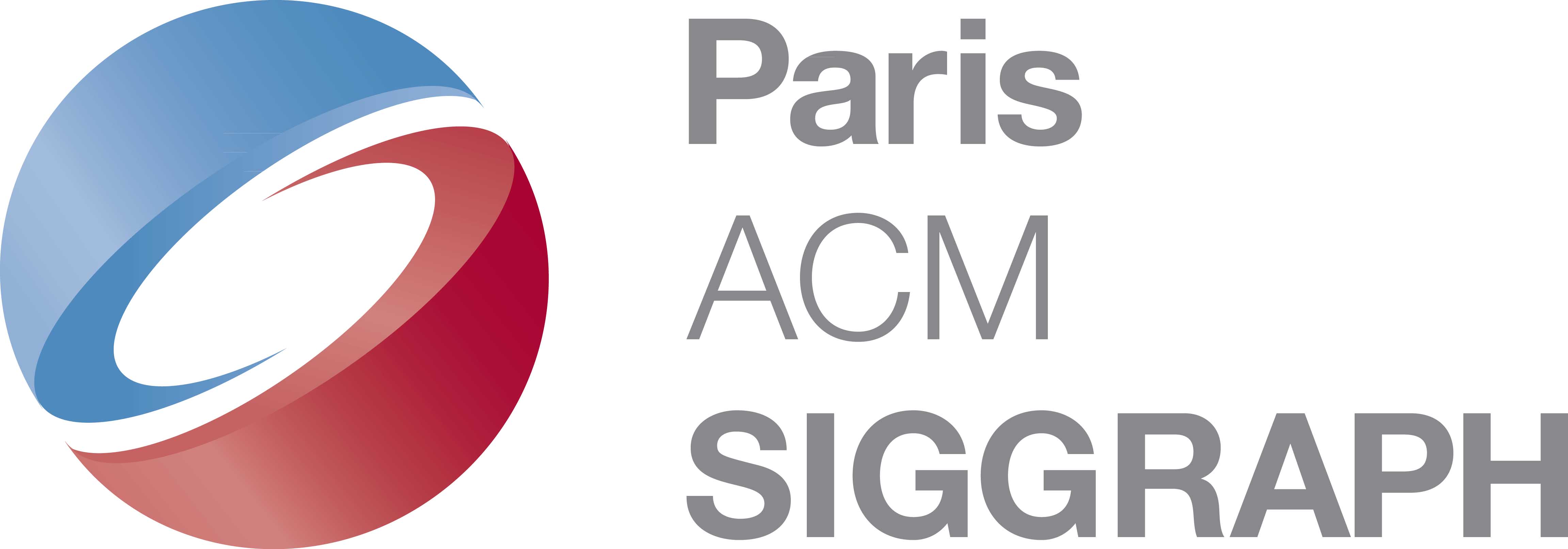
Paris ACM Siggraph, the French chapter of ACM Siggraph, worldwide non-profit organization of computer graphics.

Les Algoristes, an association of artists using their own algorithms in their work.
